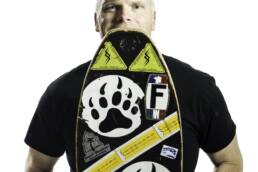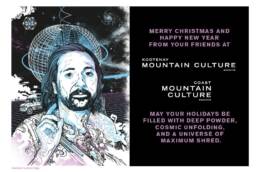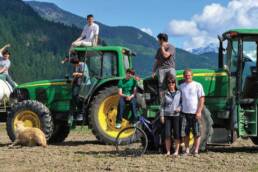From Calgary to the Coast Range, the Achenbach family has helped guide snowboarding’s rise across Canada and the world. By Louis Bockner and Darren Davidson.
It was late afternoon on a powdery December day in 1980 when a kid named Ken Achenbach unknowingly took his first step into snow-sport history. It was not amongst the dumps and bumps of Whistler or Banff but on a gust-swept prairie hill in the hardscrabble Calgary, Alberta, neighbourhood of Montgomery, overlooking the arc of the icy Bow River.
Achenbach, 15, had just zipped home after school to unpackage a snowboard bought directly from Southern California visionary skateboarder Tom Sims. “I took it across the street from my house,” says Achenbach, recalling his first few turns, “and I thought, ‘Oh my God! This is the greatest thing ever.’”
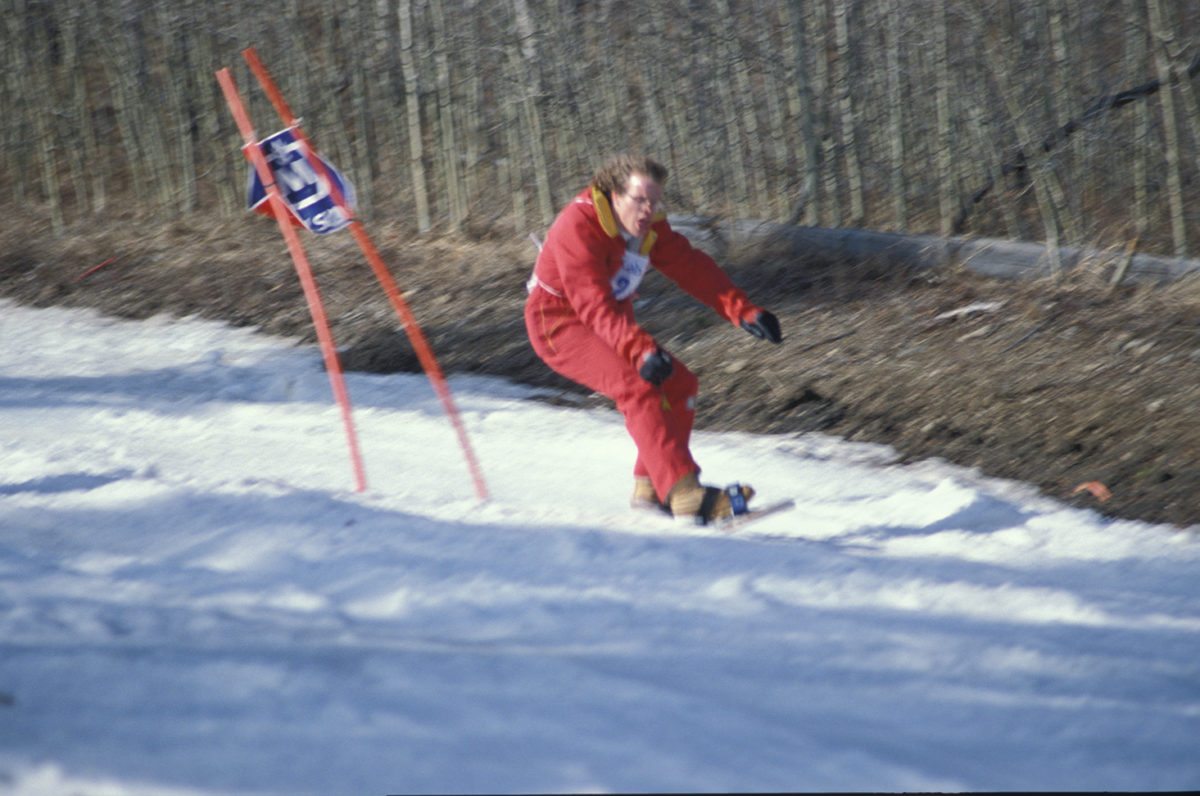
Today, the 52-year-old’s resumé is stacked with entries of a true pioneer: owner of the world’s first exclusive snowboard shop, co-inventor of an archetype snowboard design, and landscape architect of the terrain-park prototype used by resorts around the world. Over the years, the media coverage has lauded Achenbach as the founding father of Canadian snowboarding. But most tale-tellers have it wrong. “I’m not the one who founded snowboarding here,” he says. “It was my mom.”
Hilary Achenbach was a single mother of four boys, Carl, Ken, Chris and Dave, all of whom had a hand in starting Calgary’s The Snoboard Shop, based out of their garage. “She mortgaged her house to help open a store for a sport that didn’t even exist,” he says. Ken Achenbach had made a decision earlier that year that defied the maturity of most 15-year-olds. As a competitive ski racer based out of Calgary’s bare-bones Paskapoo ski hill, now the world-class WinSport Winter Sport Institute, he realized the financial pressure his Olympic skiing dreams would put on his mother—so, he quit. But turning his back on the mountains proved impossible. That’s when he discovered snowboarding, a fledgling sport taking root in California, thanks to people like Sims, a skateboarder who grew up in New Jersey needing something to do when winter ice covered curbs and pavement. “What I really liked about it is that it was totally useless,” Achenbach says, when asked what sparked the instant love affair with snowboarding. “There was no reward to it other than actually doing it, and that made it really pure. The only people who did it only did it for the boarding, not for Olympics or money or chicks. I mean chicks hated us.”
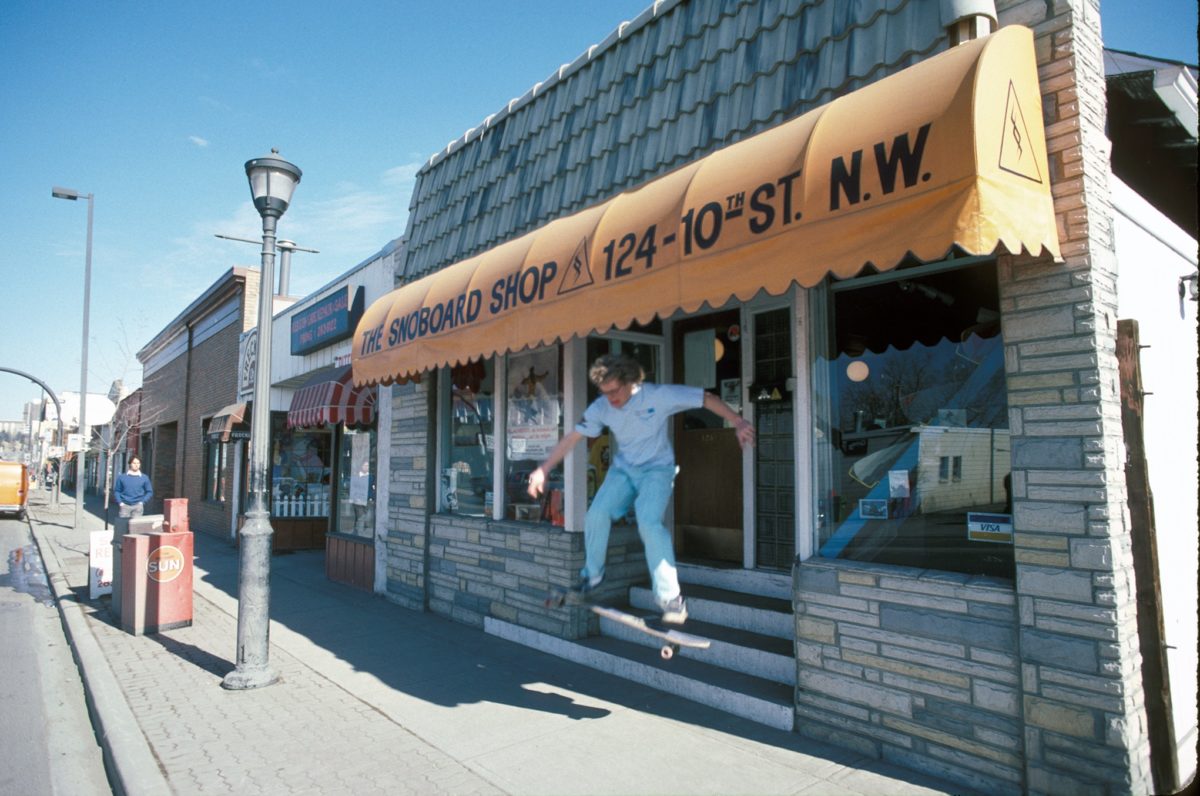
Achenbach would quickly order another six boards, certain they’d sell in some of the ski shops around town. All his offers were declined, including one he made to future Lululemon founder and fellow-Calgarian Chip Wilson, who around the same time would go on to create the Westbeach apparel company, which capitalized on upward trends in surf, skate and, eventually, snowboard clothing. So the family decided to open The Snowboard Shop in the garage and it flourished. In 1983 they moved it to downtown Calgary’s Kensington district. Ken was the businessman, and younger brother Dave was the athlete and ambassador. “Dave was such a great snowboarder,” Ken recalls. “He was the scout for the shop’s team. It was super-important to find good riders.”
Ken Achenbach’s resumé is stacked with entries of a true pioneer: owner of the world’s first exclusive snowboard shop, co-inventor of an archetype snowboard design, and landscape architect of the terrain-park prototype used by resorts around the world.
As a competitor in events that included moguls, Dave landed podium finishes in the first wave of competing boarders, alongside early icons like Craig Kelly. In 1987, the Achenbach name, and the sport, launched to new heights when a US-based editorial team travelled north to cover the shop’s annual May long weekend competition held at Sunshine Village. The North American Championships was snowboarding’s earliest must-attend event, with an impressive $20,000 purse. The day before the competition, a photographer captured an image of Dave in a natural quarter pipe just beyond Sunshine’s boundary, and the image was used as TransWorld Snowboarding’s cover shot for their premiere issue later that year. According to a former editor of the magazine, The Snoboard Shop sold about 20 per cent of all copies worldwide— 2,000 issues. (Today, the quarterly is the most widely subscribed snowboard magazine in the world, with over 1.3 million copies sold annually.) It was also in 1987 when the brothers, along with Calgary’s Neil Deffern, convinced snowboard manufacturing star Chuck Barfoot, an original employee of Sims, to build the revolutionary Barfoot Twin-Tip. The board become the industry’s standard shape, vastly improving riders’ options and abilities, and enabling now-standard moves such as the 180.
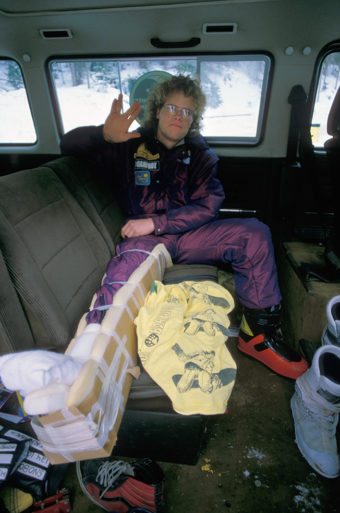
It was snowboarding’s curtain call. Wrigley’s gum featured Craig Kelly and Tom Burt in a national television commercial shot by Greg Stump. The first snowboarding World Cup series was held the next year, with corporate backers including O’Neill, Suzuki and Swatch. And a graphic artist named Geoff McFetridge worked with The Snoboard Shop, went on to be the art director of the acclaimed underground Beastie Boys magazine Grand Royal. Achenbach says McFetridge was one of the shop’s cultural influencers and was the “first ever T-shirt silk screener to figure out how to put fluorescent colours on black T-shirts,” a fashion flare that would help define the 80s. McFetridge is now an artist based in Los Angeles and has worked for media giants, such as The New York Times and The Atlantic, as well as brands like Nike, Gap and Pepsi.
Yet, even with legit fame and positive fiscal returns, the initial decade of snowboarding in Canada was met with genuine and long-lasting disdain by ski resorts and skiers. Ionically, it was Achenbach’s family ties to the ski community that allowed him to ride the resorts of Alberta relatively unmolested, while boarders in British Columbia were being berated and forced to boot pack up hills for their turns. “The first resort we ever rode at was Fortress, in 1980, but only because we were friends with the kids whose parents owned the place,” Achenbach says, laughing. “And the hill was so broke; they’d take anyone willing to pay.” Norquay eventually accepted snowboarders, and Lake Louise followed, but only allowed the Snoboard Shop’s “pro team” at first, which just happened to be made up of the Achenbach brothers and all their buddies. “We were really lucky,” Achenbach says. “My mum and dad were ski patrollers in the 50s and grew up ski racing, [so] they couldn’t pull that ‘You’re a piece of shit’ stuff on us because they were all our friends.”
The pressure would push over the Rockies into the BC Interior. Kelowna’s Doug Lundgren, a professional boarder, and Lester Quitzau, now a Juno Award–winning musician, lobbied provincial ministry officials and resort managers at Big White for on-hill inclusion, which they eventually got. Lundgren then went on to run the Snoboard Shop in Whistler and he became the first snowboarder to work at Mike Wiegele’s Heli-Skiing.
Achenbach still lives in Whistler and enjoys a life of productivity and play that would make any snow bum jealous. But there’ve been hardships, though. He’s watched the glacier diminish in the past few decades to the point where the Camp of Champions declared bankruptcy last spring due to lack of snow.
It was 1988 when Ken Achenbach decided to leave Calgary, move to Whistler and open the second Snoboard Shop, which he slept in the back of for two months to save money. A year later, he founded Camp of Champions, the first summer camp for snowboarders on Whistler’s Horstman Glacier. Today, Achenbach is still in Whistler and enjoys a life of productivity and play that would make any snow bum jealous. But there have been hardships, though. His shop and its multiple locations have all closed. He’s watched the glacier diminish in the past few decades to the point where the Camp of Champions declared bankruptcy last spring due to lack of snow, and this decision to axe his dearest project was one of the toughest in his life. Yet Achenbach remains upbeat. He jokes that he might become a real-estate agent. “If I can’t sell snow, I’ll sell dirt,” he says. “And that ain’t disappearing.”
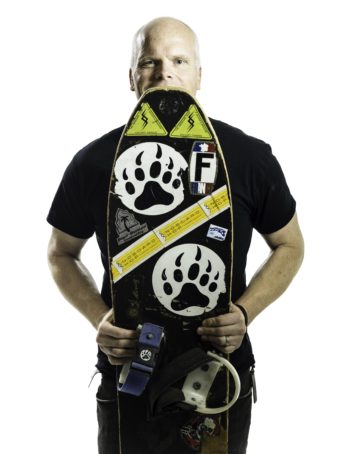
He has other ventures to keep him busy. In 2002, he and fellow snowboard legend Dan Schwartz bought Powder Mountain Catskiing, as a business venture and a way to get their powder fix close to home. And in 2012, he started Pro Standard, a company that creates innovative accessories for GoPro cameras, most of which are designed by Achenbach himself. When asked about his retirement plans, he laughs. “You have to have a job to retire.” As he talks, the depth of his life and dedication become clear. His will to follow his own path offers a glimpse of the rewards that lie beyond leaps of faith. Like all mutually beneficial relationships, it’s hard to determine which party is getting the better end of the deal. Achenbach has given his whole life to snowboarding but sacrificed two marriages along the way. He and Dave, who has three boys of his own, no longer speak. “I miss Dave,” says Achenbach, who has two daughters. (Dave declined an offer to contribute to this story.)
The family’s matriarch, Hilary, is now 87 years old and still lives in the same house where it all started: a family, a business, a sport and a culture. All grew from nearly nothing. And in return, Ken Achenbach has been provided with almost everything. “It’s given me my whole life, and, luckily, it’s all I ever wanted,” he says. “I guess I’m pretty easy to please: too dumb to do anything else and smart enough to not want to.”
Related Stories
KAVU Canada Lands First in Fernie
On March 22, 2014 KAVU & Elevation Showcase Presents KAVU Canada. KAVU athletes and KAVU staff will be dropping…
DeVitos Shoes: A Family Tradition
Any small business knows that with some hard-work and dedication, success is the outcome of what you put into…
Ale In The Family
Meet the Millers. They farm potatoes. And now they're farming beer too. Writer Lisa Richardson digs in. The first thing…
Surf Canada Now Ranked Top 10 In The World
Thanks to an historic showing at the World Surfing Games in Japan, the Surf Canada team is now ranked 10th overall in…


